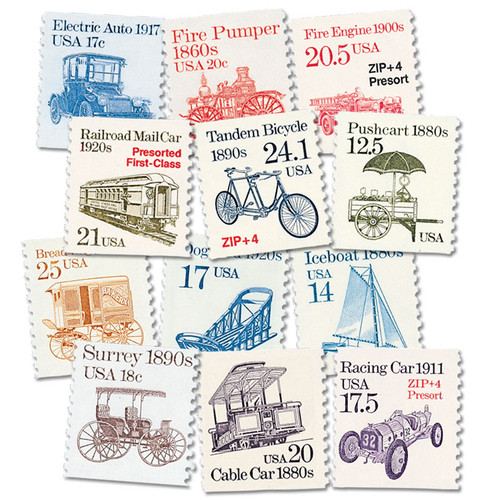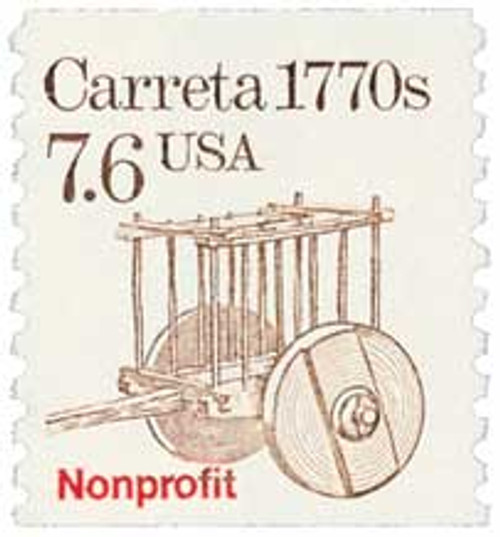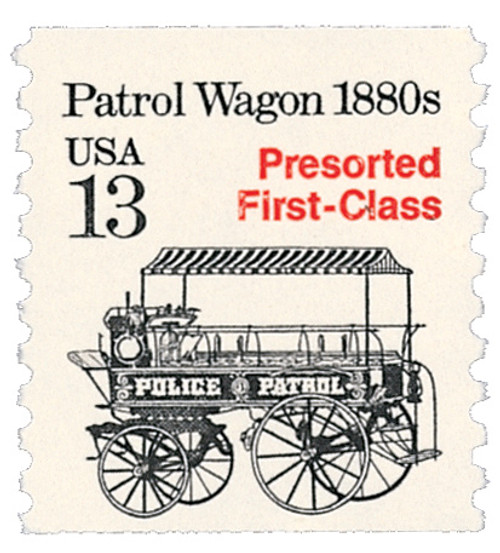
# 2260 - 1988 15c Transportation Series: Tugboat, 1900s
U.S. #2260
1988 15¢ Tugboat, 1900s
Transportation Series
- 34th stamp in the Transportation Series
- 2nd stamp in series to picture a watercraft
Stamp Category: Definitive
Series: Transportation
Value: 15¢, paid the postcard rate
First Day of Issue: July 12, 1988
First Day City: Long Beach, California
Quantity Issued: 275,751,000
Printed by: Bureau of Engraving and Printing
Printing Method: Engraved
Format: Coils of 500 and 3,000
Perforations: 10 vertical
Color: Violet
Why the stamp was issued: This stamp replaced the 1985 14¢ Iceboat stamp to pay the postcard rate. A strip of three could also be used for international airmail or first-class letters weighing one to two ounces.
About the stamp design: Richard Schlecht created line drawing on this stamp based on several photographs from the Smithsonian. The tugboat depicted was common at the start of the 1900s with his large smokestack and guarded hull. The “1900s” included in the design is meant to indicate the decade 1900-1909, not the century as a whole.
First Day City: The First Day ceremony for this stamp was held aboard the Queen Mary in the Long Beach, California harbor.
Unusual fact about this stamp: In addition to imperforate errors, this stamp has been found with a “phantom plate number” caused by a plate flaw. This was likely the result of a tool being dropped onto the plate, about two millimeters below the tugboat image. The mark is found on the ninth stamp to the right of the real plate number. It’s only found once every 18 rolls produced by plate 1.
About the Transportation Series: On May 18, 1981, the USPS issued the first stamp in the Transportation Series, US #1907, picturing the Surrey, a doorless four-wheeled carriage. For the first time in US history, a coil stamp featured its own unique design rather than simply copying that of the current definitive stamp. Over 50 more coil stamps would be issued over the course of the next 15 years, each picturing a different mode of transportation. All of these types of transportation were used since American independence.
The various denominations provided face values to exactly match the rates for several categories of Third-Class mail (bulk rate and quantity-discounted mail). As the rates changed, new stamps with new values were added. Never before had a stamp series included so many fractional cent values.
The Bureau of Engraving and Printing printed most of the stamps in the Transportation Series, although private contractors printed a few. All but a few of the later stamps were produced by engraved intaglio. Differences in precancels, tagging, paper and gum provide a large number of varieties.
Scott Catalog separates the Transportation stamps into four groups. The stamps in the first group (#1897-1908) generally have the denomination in small type with a “c” next to it. These stamps were printed on the Cottrell rotary press, which joined together two plates to make a sleeve. The gaps between these plates created depressions where ink would collect and create joint lines on the stamps. Later issues were printed on a different press and didn’t have these joint lines.
The second group (#2123-36) had larger numbers with no “c.” The third group (#2252-66) was similar in appearance to the second group, but service inscriptions were added to the designs. These stamps also used a variety of paper and gum as well as different types of tagging. The fourth group (#2451-68) marked the end of fractional values. Now bulk mailers would use either the 5¢ or 10¢ stamp and then pay the difference from the actual postage rate.
The last stamp in the Transportation Series, the 20¢ Cog Railway, was issued on June 9, 1995, at the TEXPEX ’95 stamp show in Dallas, Texas. This marked the end of the largest US definitive series up to that time. Three new series would eventually replace it – American Transportation, American Culture, and American Scenes. Additionally, the Great Americans would go on to become the largest American definitive series.
History the stamp represents: By helping larger ships with docking and sailing, the tiny but powerful tugboat helps keep traffic flowing smoothly and safely in the world's seaports. Before the Revolutionary War, rowboats manned by eight to ten men were used as tugs.
U.S. #2260
1988 15¢ Tugboat, 1900s
Transportation Series
- 34th stamp in the Transportation Series
- 2nd stamp in series to picture a watercraft
Stamp Category: Definitive
Series: Transportation
Value: 15¢, paid the postcard rate
First Day of Issue: July 12, 1988
First Day City: Long Beach, California
Quantity Issued: 275,751,000
Printed by: Bureau of Engraving and Printing
Printing Method: Engraved
Format: Coils of 500 and 3,000
Perforations: 10 vertical
Color: Violet
Why the stamp was issued: This stamp replaced the 1985 14¢ Iceboat stamp to pay the postcard rate. A strip of three could also be used for international airmail or first-class letters weighing one to two ounces.
About the stamp design: Richard Schlecht created line drawing on this stamp based on several photographs from the Smithsonian. The tugboat depicted was common at the start of the 1900s with his large smokestack and guarded hull. The “1900s” included in the design is meant to indicate the decade 1900-1909, not the century as a whole.
First Day City: The First Day ceremony for this stamp was held aboard the Queen Mary in the Long Beach, California harbor.
Unusual fact about this stamp: In addition to imperforate errors, this stamp has been found with a “phantom plate number” caused by a plate flaw. This was likely the result of a tool being dropped onto the plate, about two millimeters below the tugboat image. The mark is found on the ninth stamp to the right of the real plate number. It’s only found once every 18 rolls produced by plate 1.
About the Transportation Series: On May 18, 1981, the USPS issued the first stamp in the Transportation Series, US #1907, picturing the Surrey, a doorless four-wheeled carriage. For the first time in US history, a coil stamp featured its own unique design rather than simply copying that of the current definitive stamp. Over 50 more coil stamps would be issued over the course of the next 15 years, each picturing a different mode of transportation. All of these types of transportation were used since American independence.
The various denominations provided face values to exactly match the rates for several categories of Third-Class mail (bulk rate and quantity-discounted mail). As the rates changed, new stamps with new values were added. Never before had a stamp series included so many fractional cent values.
The Bureau of Engraving and Printing printed most of the stamps in the Transportation Series, although private contractors printed a few. All but a few of the later stamps were produced by engraved intaglio. Differences in precancels, tagging, paper and gum provide a large number of varieties.
Scott Catalog separates the Transportation stamps into four groups. The stamps in the first group (#1897-1908) generally have the denomination in small type with a “c” next to it. These stamps were printed on the Cottrell rotary press, which joined together two plates to make a sleeve. The gaps between these plates created depressions where ink would collect and create joint lines on the stamps. Later issues were printed on a different press and didn’t have these joint lines.
The second group (#2123-36) had larger numbers with no “c.” The third group (#2252-66) was similar in appearance to the second group, but service inscriptions were added to the designs. These stamps also used a variety of paper and gum as well as different types of tagging. The fourth group (#2451-68) marked the end of fractional values. Now bulk mailers would use either the 5¢ or 10¢ stamp and then pay the difference from the actual postage rate.
The last stamp in the Transportation Series, the 20¢ Cog Railway, was issued on June 9, 1995, at the TEXPEX ’95 stamp show in Dallas, Texas. This marked the end of the largest US definitive series up to that time. Three new series would eventually replace it – American Transportation, American Culture, and American Scenes. Additionally, the Great Americans would go on to become the largest American definitive series.
History the stamp represents: By helping larger ships with docking and sailing, the tiny but powerful tugboat helps keep traffic flowing smoothly and safely in the world's seaports. Before the Revolutionary War, rowboats manned by eight to ten men were used as tugs.





















